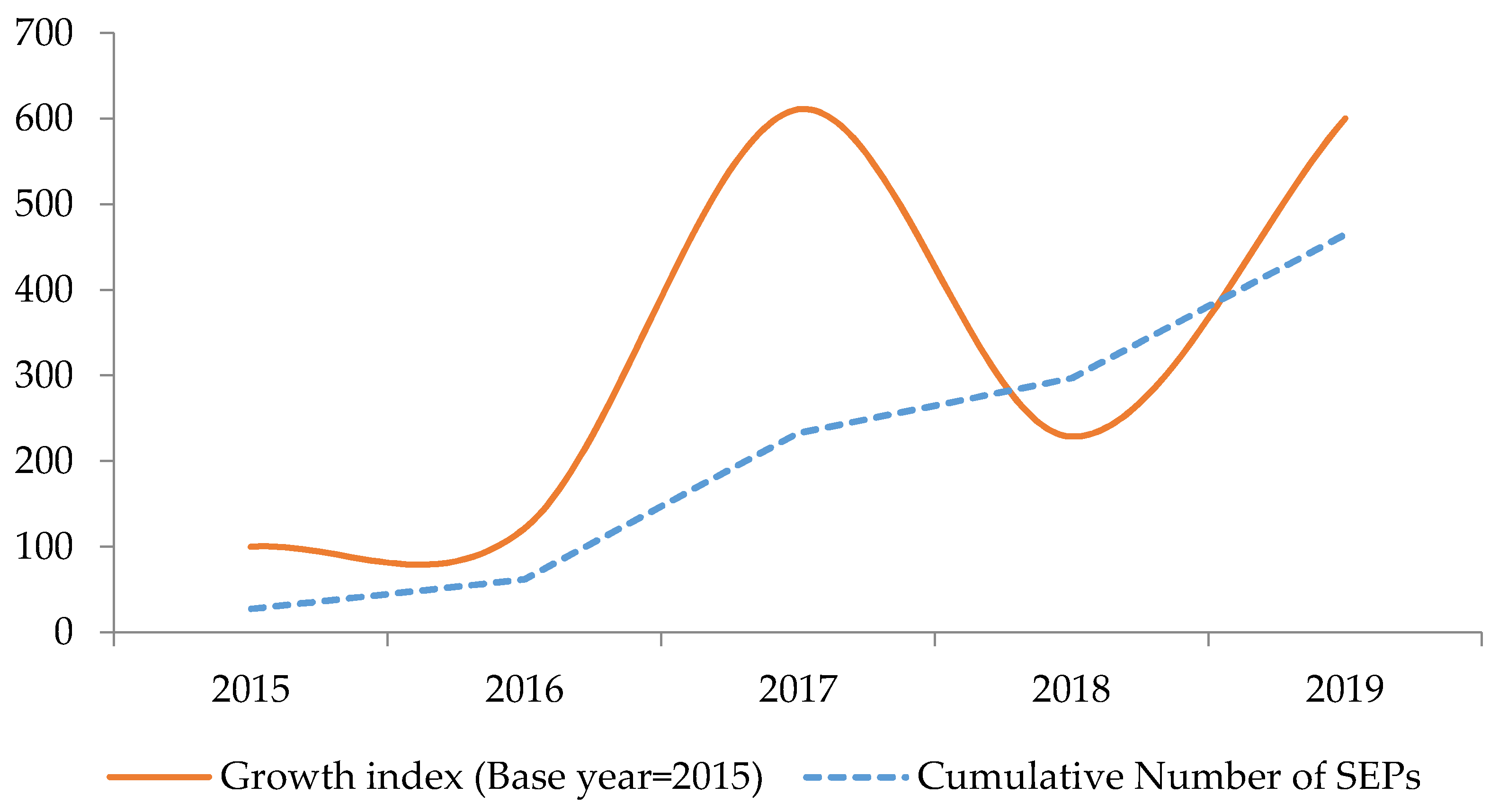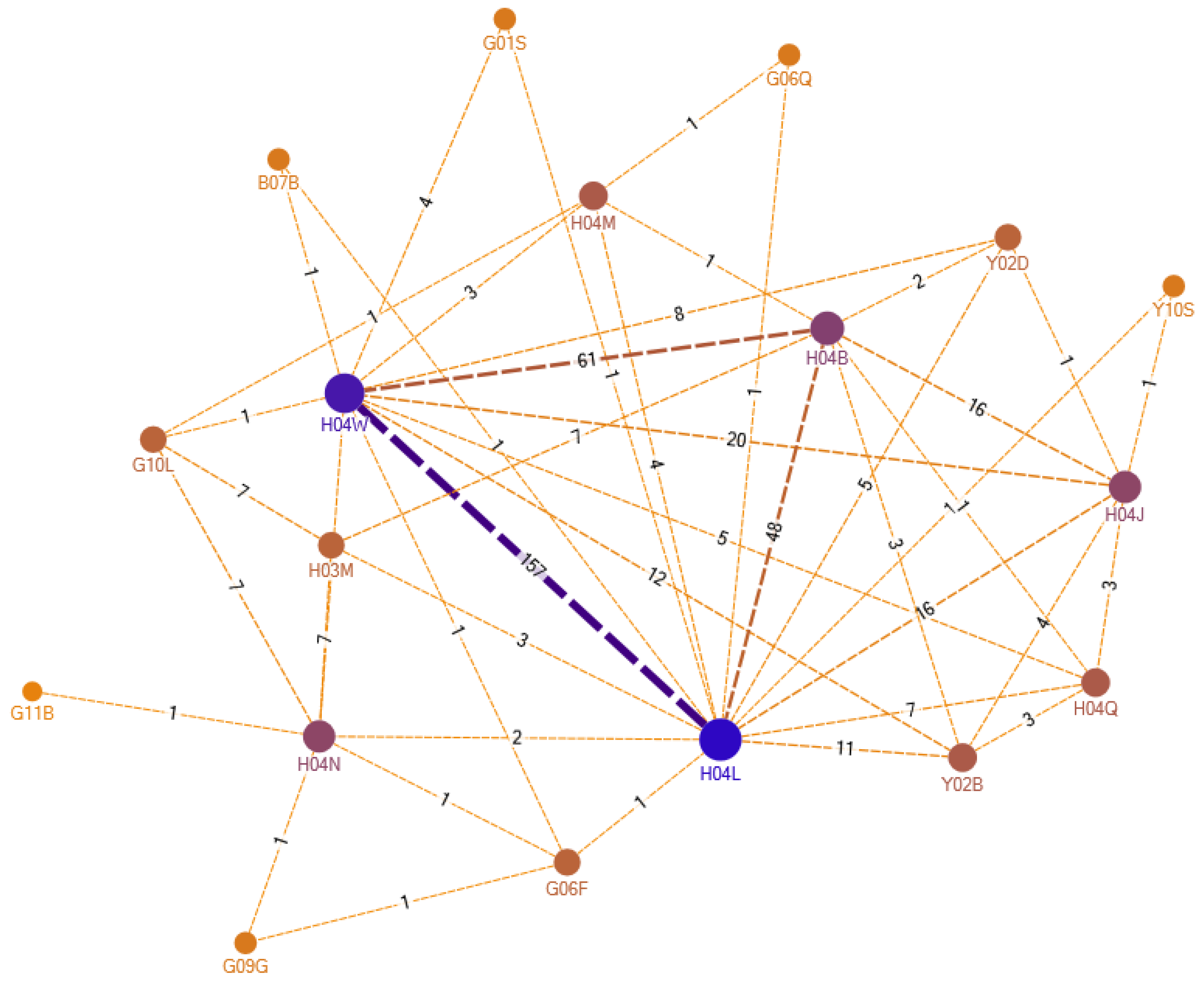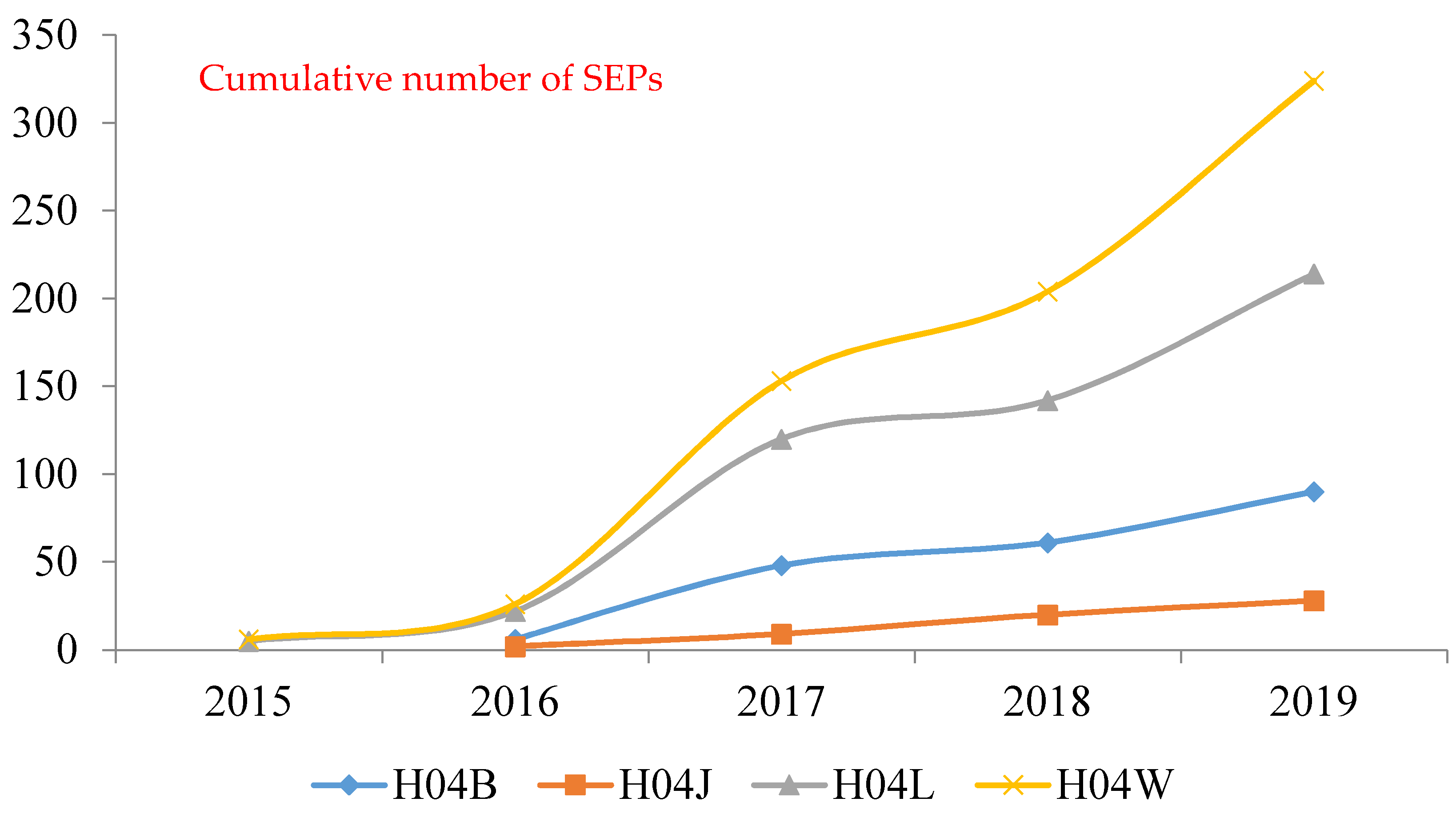Analyses of the Key Technologies and Development Trends of Optical Networks from the Perspective of Standard Essential Patents
Abstract
Featured Application
Abstract
1. Introduction
2. Literature Review
2.1. Current Development of Optical Networks
2.2. Network Analyses of Technologies Licensed with SEPs
3. Research Design
3.1. Search Strategy and Data Source
3.2. Centrality Analyses
3.2.1. Closeness Centrality
3.2.2. Eigenvector Centrality
3.2.3. Fragmentation Centrality
4. Results
4.1. Patent Search Results
4.2. Technology Network Analysis
4.3. Post Analysis: Yearly Changes of the Key Technologies in SEPs Optical Networks
5. Conclusions
5.1. Discussion and Implications
5.2. Limitations and Future Research Directions
Funding
Informed Consent Statement
Data Availability Statement
Acknowledgments
Conflicts of Interest
Appendix A
| CPC Categories | Meaning |
|---|---|
| H04B | Transmission |
| H04J | Multiplex communication |
| H04L | Transmission of digital information, e.g., telegraphic communication |
| H04N | Pictorial communication, e.g., television |
| H04Q | Selecting |
| H04W | Wireless communication networks |
References
- Optical Interconnect Market by Product Category, Interconnect Level, Fiber Mode, Data Rate, Distance, Application, Region-Global Forecast to 2025; MarketsandMarkets: Northbrook, IL, USA, 2020.
- Khan, I.; Ahmad, A.; Masood, M.U.; Malik, A.W.; Ahmed, N.; Curri, V. Impact of data center placement on the power consumption of flexible-grid optical networks. Opt. Eng. 2020, 59, 016115. [Google Scholar] [CrossRef]
- Ma, J.; Israel, S. Virtualized networks and virtualized optical line terminal (vOLT). Fiber Integr. Opt. 2017, 36, 68–77. [Google Scholar] [CrossRef]
- Yin, Y.; Liu, L.; Proietti, R.; Yoo, S.J.B. Software defined elastic optical networks for cloud computing. IEEE Netw. 2017, 31, 4–10. [Google Scholar] [CrossRef]
- Losero, E.; Ruo-Berchera, I.; Meda, A.; Avella, A.; Genovese, M. Unbiased estimation of an optical loss at the ultimate quantum limit with twin-beams. Sci. Rep. 2018, 8, 7431. [Google Scholar] [CrossRef] [PubMed]
- Tagantsev, A.K.; Fedorov, S.A. Quantum-limited measurements using an optical cavity with modulated intrinsic loss. Phys. Rev. Lett. 2019, 123, 043602. [Google Scholar] [CrossRef]
- Chen, H.; Jia, H.; Yang, J.; Tian, Y.; Wang, T. Ultra-compact switchable mode converter based on silicon and optical phase change material hybrid metastructure. Opt. Commun. 2020, 473, 125889. [Google Scholar] [CrossRef]
- Miller, K.J.; Hallman, K.A.; Haglund, R.F.; Weiss, S.M. Silicon waveguide optical switch with embedded phase change material. Opt. Express 2017, 25, 26527–26536. [Google Scholar] [CrossRef] [PubMed]
- Optical Networking Opportunities in the 5G Infrastructure Market: 2019 To 2028; Communications Industry Researchers: Crozet, VA, USA, 2019.
- Kim, J.; Lee, S. Forecasting and identifying multi-technology convergence based on patent data: The case of IT and BT industries in 2020. Scientometrics 2017, 111, 47–65. [Google Scholar] [CrossRef]
- You, H.; Li, M.; Hipel, K.; Jiang, J.; Ge, B.; Duan, H. Development trend forecasting for coherent light generator technology based on patent citation network analysis. Scientometrics 2017, 111, 297–315. [Google Scholar] [CrossRef]
- Li, Y.; Phelps, N.A.; Liu, Z.; Ma, H. Featured graphics: The landscape of Chinese invention patents: Quantity, density, and intensity. Environ. Plan. A 2019, 51, 823–826. [Google Scholar] [CrossRef]
- Stoffels, M.A.; Klauck, F.J.R.; Hamadi, T.; Glorius, F.; Leker, J. Technology trends of catalysts in hydrogenation reactions: A patent landscape analysis. Adv. Synth. Catal. 2020, 362, 1258–1274. [Google Scholar] [CrossRef]
- Morioka, T.; Jinno, M.; Takara, H.; Kubota, H. Innovative future optical transport network technologies. NTT Tech. Rev. 2011, 9, 1–8. [Google Scholar]
- Chang, S.H. Revealing development trends and key 5G photonic technologies using patent analysis. Appl. Sci. 2019, 9, 2525. [Google Scholar] [CrossRef]
- Katti, R.; Shanthi, P. A survey on role of photonic technologies in 5G communication systems. Photonic Netw. Commun. 2019, 38, 185–205. [Google Scholar] [CrossRef]
- Chang, S.H. Patent analysis of the critical technology network of semiconductor optical amplifiers. Appl. Sci. 2020, 10, 1552. [Google Scholar] [CrossRef]
- Saadaouil, F.; Fathallah, M.; Ragheb, A.M.; Memon, M.I.; Fathallah, H.; Alshebeili, S.A. Optimizing OSSB generation using semiconductor optical amplifier (SOA) for 5G millimeter wave switching. IEEE Access 2017, 5, 6715–6723. [Google Scholar]
- Imtiaz, W.A.; Ahmed, H.Y.; Zeghid, M.; Sharief, Y. Two dimensional optimized enhanced multi diagonal code for OCDMA passive optical networks. Opt. Quantum Electron. 2020, 52, 1–17. [Google Scholar] [CrossRef]
- Zhang, B.; Zhao, Y.; Rahman, S.; Li, Y.; Zhang, J. Alarm classification prediction based on cross-layer artificial intelligence interaction in self-optimized optical networks (SOON). Opt. Fiber Technol. 2020, 57, 102251. [Google Scholar] [CrossRef]
- Lu, Y.; Gu, H. Flexible and scalable optical interconnects for data centers: Trends and challenges. IEEE Commun. Mag. 2019, 57, 27–33. [Google Scholar] [CrossRef]
- Silicon Photonics for Data Centers and Other Applications 2016; Yole Développement: Lyon-Villeurbanne, France, 2016.
- Chang, S.H. Key technologies and development trends of 5G optical networks. Appl. Sci. 2019, 9, 4835. [Google Scholar] [CrossRef]
- Spulber, D.F. Standard setting organisations and standard essential patents: Voting and markets. Econ. J. 2019, 129, 1477–1509. [Google Scholar] [CrossRef]
- Borgatti, S.P. Identifying sets of key players in a social network. Comput. Math. Organ. Theory 2006, 12, 21–34. [Google Scholar] [CrossRef]
- Whelan, E.; Golden, W.; Donnellan, B. Digitising the R&D social network: Revisiting the technological gatekeeper. Inf. Syst. J. 2013, 23, 197–218. [Google Scholar]
- Kwon, O.; An, Y.; Kim, M.; Lee, C. Anticipating technology-driven industry convergence: Evidence from large-scale patent analysis. Technol. Anal. Strateg. Manag. 2020, 32, 363–378. [Google Scholar] [CrossRef]
- Choi, J.Y.; Jeong, S.; Jung, J.K. Evolution of technology convergence networks in Korea: Characteristics of temporal changes in R&D according to institution type. PLoS ONE 2018, 13, e0192195. [Google Scholar]
- SEP Analysis; IPlytics: Berlin, Germany, 2019.
- Borgatti, S.P.; Everett, M.G.A. Graph-theoretic perspective on centrality. Soc. Netw. 2006, 28, 466–484. [Google Scholar] [CrossRef]
- Morsy-Osman, M.; Sowailem, M.; El-Fiky, E.; Goodwill, T.; Hoang, T.; Lessard, S.; Plant, D.V. DSP-free ‘coherent-lite’ transceiver for next generation single wavelength optical intra-datacenter interconnects. Opt. Express 2018, 26, 8890–8903. [Google Scholar] [CrossRef] [PubMed]
- Sowailem, M.Y.S.; El-Fiky, E.; Morsy-Osman, M.; Zhuge, Q.; Hoang, T.M.; Paquet, S.; Paquet, C.; Woods, I.; Liboiron-Ladouceur, O.; Plant, D.V. Self-homodyne system for next generation intra-datacenter optical interconnects. Opt. Express 2017, 25, 27834–27844. [Google Scholar] [CrossRef]
- Shimosawa, K.; Uenohara, H. Subchannel drop and add operation by using silicon photonic all-optical orthogonal frequency division multiplexing demultiplexers. Opt. Lett. 2020, 45, 3852–3855. [Google Scholar] [CrossRef] [PubMed]
- Xu, S.; Wang, J.; Zou, W. Optical patching scheme for optical convolutional neural networks based on wavelength-division multiplexing and optical delay lines. Opt. Lett. 2020, 45, 3689–3692. [Google Scholar] [CrossRef] [PubMed]
- ETST. ETSI Launches New Group on 5th Generation Fixed Network Shifting the Paradigm from Fibre to the Home to Fiber to Everything Everywhere. Available online: https://www.etsi.org/newsroom/press-releases/1723-2020-02-etsi-launches-new-group-on-5th-generation-fixed-network-shifting-the-paradigm-from-fibre-to-the-home-to-fiber-to-everything-everywhere (accessed on 28 July 2020).
- Landscaping Study on Standard Essential Patents (SEPs); IPlytics: Berlin, Germany, 2019.



| Ranking | Patent Office | Frequency | Percentage |
|---|---|---|---|
| 1 | WIPO | 185 | 39.78% |
| 2 | CNIPA | 96 | 20.65% |
| 3 | EPO | 69 | 14.84% |
| 4 | USPTO | 38 | 8.17% |
| 5 | KIPO | 27 | 5.81% |
| CPC | Closeness Centrality | CPC | Eigenvector Centrality | CPC | Fragmentation Centrality |
|---|---|---|---|---|---|
| H04L | 15.500 | H04L | 0.448 | H04L | 0.552 |
| H04W | 14.500 | H04W | 0.419 | H04N | 0.551 |
| H04B | 12.167 | H04B | 0.340 | H04W | 0.532 |
| H04N | 12.000 | H04J | 0.304 | H04B | 0.513 |
| H04J | 11.667 | H04Q | 0.261 | H04J | 0.510 |
Publisher’s Note: MDPI stays neutral with regard to jurisdictional claims in published maps and institutional affiliations. |
© 2021 by the author. Licensee MDPI, Basel, Switzerland. This article is an open access article distributed under the terms and conditions of the Creative Commons Attribution (CC BY) license (http://creativecommons.org/licenses/by/4.0/).
Share and Cite
Chang, S.-H. Analyses of the Key Technologies and Development Trends of Optical Networks from the Perspective of Standard Essential Patents. Appl. Sci. 2021, 11, 1583. https://doi.org/10.3390/app11041583
Chang S-H. Analyses of the Key Technologies and Development Trends of Optical Networks from the Perspective of Standard Essential Patents. Applied Sciences. 2021; 11(4):1583. https://doi.org/10.3390/app11041583
Chicago/Turabian StyleChang, Shu-Hao. 2021. "Analyses of the Key Technologies and Development Trends of Optical Networks from the Perspective of Standard Essential Patents" Applied Sciences 11, no. 4: 1583. https://doi.org/10.3390/app11041583
APA StyleChang, S.-H. (2021). Analyses of the Key Technologies and Development Trends of Optical Networks from the Perspective of Standard Essential Patents. Applied Sciences, 11(4), 1583. https://doi.org/10.3390/app11041583






